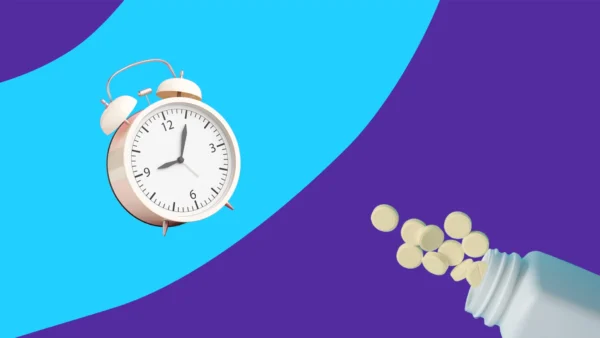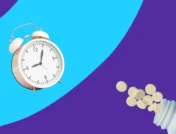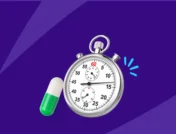Common atenolol side effects | Serious side effects | Bradycardia | Leg pain | Nausea | Diarrhea | Side effects timeline | Contraindications | Warnings | Interactions | How to avoid side effects | How to treat side effects
Atenolol is a generic drug prescribed to treat high blood pressure, chest pain (angina pectoris), or to increase the chances of survival following a heart attack (myocardial infarction). Some people are prescribed atenolol off-label for atrial fibrillation, fast heartbeats, migraines, tremor, or alcohol withdrawal. Also prescribed as brand-name Tenormin, atenolol is a cardioselective beta blocker and available as combination product with a diuretic, meaning, it not only widens blood vessels like other beta blockers, but it also has strong effects on the heart in slowing down the rate of heartbeats. Like similar beta blockers, atenolol has many side effects. Many of them are related to blood pressure and the heart.
RELATED: What is atenolol?
Common side effects of atenolol
The most likely side effects of atenolol depend on the medical condition being treated. People taking atenolol for heart conditions are more likely to experience serious side effects.
In order of incidence, the most common side effects for people taking atenolol for hypertension are:
- Tiredness
- Dizziness
- Cold fingers, toes, hands, and feet
- Depression
- Fatigue
- Shortness of breath
- Nausea
- Diarrhea
- Feeling faint when standing up
For people given atenolol following a heart attack, the most common side effects are serious side effects. Keep in mind, however, that people who have had a heart attack are at risk for serious heart problems, including death, in the days and weeks following a heart attack. Atenolol combined with conventional treatment lowers the risk of most of these serious problems including size of infarct, irregular heartbeats, heart failure, a secondary heart attack, and death. People may still experience these problems, but they are not side effects of atenolol. They are consequences of a heart attack. However, atenolol does increase the risk for some serious problems. In order of likelihood, the most common side effects of atenolol treatment following a heart attack are:
- Low blood pressure
- Slow heart rate
Serious side effects of atenolol
Again, the likelihood of serious side effects due to atenolol will be based on the medical condition being treated or whether atenolol is taken orally or injected. People with serious heart problems are more likely to experience cardiovascular problems than people given atenolol for blood pressure, migraines, or tremor. The most serious side effects of atenolol are:
- Heart block
- Pulmonary embolism
- Airway closure (bronchospasm)
- Kidney failure
- Severe allergic reactions
People taking atenolol for chest pain due to coronary artery disease are at risk for serious side effects such as worsened angina, occurrence of a heart attack, or irregular heartbeats if atenolol is stopped suddenly.
Bradycardia
Slowing the heart and reducing the strength of individual heartbeats are the intended effects of atenolol treatment. Both effects reduce blood pressure and the incidence of chest pain. They also reduce how much work the heart has to do, a benefit for people who have just had a heart attack. These effects can also help improve irregular heartbeats. However, sometimes a slow heartbeat can be a problem. If it’s too slow, the heart will not be pumping enough blood and oxygen to the body. If the heart rate seems too slow, then talk to the prescribing healthcare provider. If symptoms are experienced, then immediate medical care is required.
Leg pain
Leg pain is not a commonly-experienced side effect of atenolol. In combined U.S. and foreign trials, approximately 3% of participants complained of leg pain or leg cramps, but as of yet, there is no explanation for why. If leg pain is debilitating or doesn’t go away, then ask the prescriber for medical advice.
Nausea
Approximately 3% to 4% of participants in atenolol clinical trials reported nausea, a common side effect of most oral drugs. While nausea is generally a temporary and mild side effect, talk to the prescribing doctor if it’s severe, accompanied by persistent vomiting, or interferes significantly with daily life.
Diarrhea
Diarrhea is not commonly experienced in people using atenolol. In clinical trials, the incidence was between 2% and 3%. For most people taking atenolol, diarrhea will be mild and temporary. It should be reported to the healthcare provider if diarrhea is watery, bloody, or doesn’t go away.
How soon do atenolol side effects start?
Atenolol begins working on slowing the heart within an hour of the first dose, so some side effects such as slow heart rate and low blood pressure may be experienced within an hour or two of taking the first dose. Most of the common side effects generally occur early in treatment. These include dizziness, drowsiness, fatigue, nausea, and diarrhea. Some of the more serious side effects are delayed side effects, requiring several weeks or months of treatment to become obvious.
How long do atenolol side effects last?
Mild side effects of atenolol may improve over time, but any effects involving slow heartbeats or blood pressure may require lower doses to improve. Any side effects that don’t get better over time will usually improve when the drug is stopped. With a half-life of six to seven hours, atenolol is pretty much cleared from the body in a day.
What are the long-term side effects of atenolol?
For some conditions, atenolol is meant to be taken daily for months or years. There are no side effects specifically caused by long-term use.
Atenolol contraindications
Because atenolol slows the heart, it is never prescribed to people with:
- Slow heartbeat due to a problem with the heart’s natural “pacemaker” (sinus bradycardia)
- Moderate to serious heart block
- Congestive heart failure
- A heart that doesn’t pump enough blood or oxygen to the body (cardiogenic shock)
Atenolol is also contraindicated in any person allergic to the drug.
Pregnancy
Atenolol should be avoided during pregnancy, particularly in the second and third trimesters. Atenolol does cross the placenta and could cause birth defects or low birth weight.
Breastfeeding
Atenolol is not recommended for nursing mothers. The drug is present in human breast milk and could cause low blood pressure or slow heartbeats in the nursing infant.
Children
The FDA has not approved atenolol for use in children or adolescents. Healthcare providers, though, may prescribe atenolol for children with high blood pressure, irregular heartbeats (supraventricular arrhythmias), or heart problems associated with Marfan syndrome.
Seniors
Atenolol is prescribed to people older than 65, but there may be issues. In general, people of advanced age do not eliminate the drug as quickly from the body as younger adults, so side effects are a greater risk. Older adults are also more likely to have conditions that may be worsened by beta blocker treatment. Healthcare providers will usually start doses as low as possible when treating seniors.
Atenolol warnings
Like all beta blockers, atenolol’s effects on blood pressure and the heart do have risks, so some situations require caution or monitoring.
Black box warning
Atenolol is packaged with an FDA black box warning that abrupt discontinuation of the drug in people taking atenolol for chest paincan worsen angina or produce irregular heartbeats.
Cautions
Some pre-existing conditions can be worsened by atenolol, so extra monitoring or dose reductions may be required.
- Cardiovascular problems: Heart failure, coronary artery disease, heart block, or irregular heartbeats may be worsened by atenolol
- Peripheral vascular disease: Problems with peripheral blood vessels such as the Raynaud phenomenon could also be worsened by atenolol
- Diabetes: Atenolol can cause diabetes or worsen poorly controlled diabetes. Additionally, it may mask signs of low blood sugar.
- Thyroid problems: Atenolol can mask symptoms of hyperthyroidism or thyroid disease
- Asthma, emphysema, or bronchitis: Atenolol can cause bronchospasm, or airway closure, as a side effect.
- Adrenal gland tumor: Atenolol can cause high blood pressure in people diagnosed with pheochromocytoma.
- Kidney disease: People with reduced kidney function may require dose reductions to prevent side effects.
- Surgery: General anesthesia and surgery are riskier in people taking beta blockers.
Abuse and dependence
Atenolol is not associated with drug abuse, dependency, or withdrawal. However, people taking atenolol for chest pain will usually be prescribed a tapering dose when the drug is discontinued to prevent worsened chest pain or irregular heartbeats.
Overdose
An overdose of atenolol can cause serious problems or death, so seek out medical treatment if too much atenolol is taken. Symptoms of an overdose include lethargy, slow breathing, slowed heart rate, low blood pressure, and wheezing. The maximum approved dosage is 200 mg per day for chest pain and 100 mg daily for all other approved conditions. Even so, never exceed the prescribed dose.
Atenolol interactions
Atenolol can be affected by other drugs or worsen the side effects of other drugs. One drug, the antidepressant Marplan (isocarboxazid), is never prescribed with blood pressure drugs.
The most concerning drug interactions affect heart rate, heart rhythm, or blood pressure. Drugs that cause these problems when combined with atenolol may require dose adjustments or extra monitoring. These include:
- Other beta blockers
- Other blood pressure drugs (such as clonidine)
- Calcium channel blockers
- Antiarrhythmics (heart rate and heart rhythm medications such as verapamil)
- Digitalis medications such as digoxin that treat heart failure and irregular heart rate
- Migraine drugs (ergots)
- Marijuana
- Cocaine
How to avoid atenolol side effects
Most people taking atenolol for high blood pressure experience only minor adverse effects. However, people who take atenolol for heart problems are at risk for more serious side effects. Preventing both mild and serious side effects is possible if a few pieces of advice are followed.
1. Tell the healthcare provider about all medical conditions
The first rule for preventing both mild and serious side effects is to make sure that the prescribing healthcare provider knows about all medical conditions both past and present. In particular, tell the prescribing healthcare provider about:
- Heart disease
- Peripheral vascular disease
- Asthma or COPD
- Diabetes
- Thyroid problems, particularly overactive thyroid
- Pheochromocytoma, a type of adrenal gland cancer
- Kidney disease
- Any upcoming major surgery
- Pregnancy or any plans to become pregnant
- Breastfeeding or plans to breastfeed
2. Tell the prescriber about all medications being taken
The second most effective way to prevent both mild and serious side effects is to make sure both the prescriber and the pharmacist know about all prescription drugs, over-the-counter medications, and supplements being used. This way, they can spot possible drug interactions before there’s a problem. The most important are:
- Blood pressure drugs, especially beta blockers or calcium channel blockers
- Heart rhythm drugs
- Migraine drugs
3. Take atenolol as instructed
Taking too much atenolol will make side effects more likely. The way to do that is to take each dose as scheduled exactly as instructed. If a dose is missed, then it can be taken when remembered. Taking it too close to the next dose, however, is like taking a double dose. In that case, skip the missed dose and take the next dose on time.
4. Stand up and move slowly
Minimize dizziness and lightheadedness by standing or sitting up slowly and moving carefully. This is especially valuable if lightheadedness happens whenever you sit up or stand.
5. Go easy on alcohol
Alcohol can worsen low blood pressure, dizziness, or drowsiness when added to atenolol.
6. Avoid caffeine
To prevent or minimize cold hands and feet, go easy on caffeinated drinks. Caffeine can restrict blood flow. It’s also a good idea not to wear tight watches or bracelets.
How to treat side effects of atenolol
Atenolol’s side effects can’t always be avoided but they can be managed. Some, though, will require the help of healthcare professionals.
Cold hands or feet
Run warm water over your fingers, hands, or feet to warm them up. Wear warm gloves, mittens, or socks.
Drowsiness or dizziness
Lie or sit down and rest. The primary goal is to avoid falls, accidents, or other injuries.
Low blood pressure
If blood pressure falls far enough to be a problem, you will experience symptoms. Call a healthcare professional if any of these symptoms occur:
- Dizziness or lightheadedness
- Confusion
- Feeling faint or fainting
- Weakness
- Tiredness
- Blurred vision
Slow heartbeats
Tell the healthcare provider if the heart is beating slowly (less than 60 beats per minute) but there are no symptoms. Get medical help, however, if there are symptoms of a slowed heart including:
- Lethargy
- Heart palpitations
- Severe dizziness or lightheadedness
- Confusion
- Weakness
- Chest pain
Sources
- Atenolol, Epocrates
- Atenolol drug summary, Prescriber’s Digital Reference
- Atenolol tablet prescribing information, U.S. National Library of Medicine
- Marplan prescribing information, U.S. National Library of Medicine











